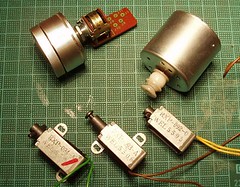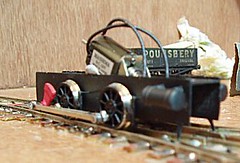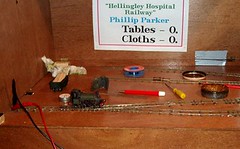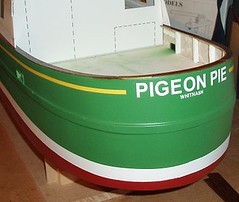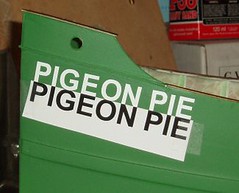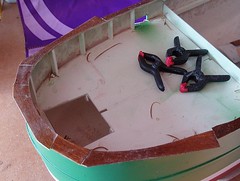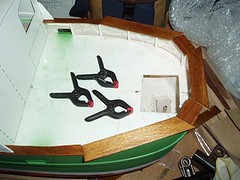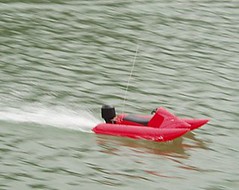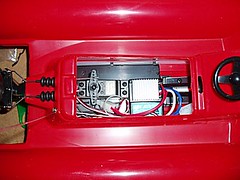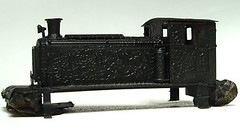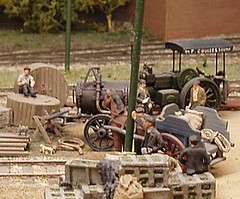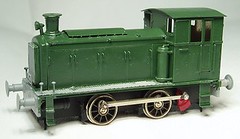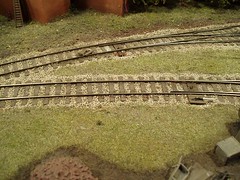A bag was thrust under my nose the other day.
“Can you use any of this stuff ?” I was asked.
I dived in along with a couple of others. They were excited about a big circuit board (“Lots of components”) and a power supply. I was the only one who recognised some solenoids (bottom row of the photo), a motor and an interesting double variable resistor. I suspect we were looking at the bones of a pretty old fashioned stereo stack system.
To be honest I’m not sure what this stuff will get used for. The solenoids work, pulling the pins in on 12V quite sharply. The motor revs slowly on the same voltage. The resistor, well it just looked interesting. With wires removed they have been secreted in the bits box to await a new lease of life.
I know I’m not alone in doing this – would anyone else like to volunteer interesting goodies that they have “rescued” ?
A daily updated blog typed by someone with painty hands, oil under his fingernails and the smell of solder in his nostrils who likes making all sort of models and miniatures. And fixing things.
Monday, February 27, 2006
Sunday, February 26, 2006
Crash, bang, wallop what a chassis
Before the yards went to bed for the summer, I’ve been testing my Barclay chassis. The model has never encountered pointwork before now as it was intended for display. Straight track testing just ensured it worked, what it didn’t highlight was the effect the over-long guard irons would have.
First time out on anything with curves and there is a lump and the controller shows a short. Those dangly bits are lower then the top of the rails !
Bending them to the correct profile helped but wasn’t easy as the soldered joints were tiny and not very strong. Two had to be re-made with superglue. Even then I shortened the irons a bit to get plenty of clearance. Not sure if the kit is at fault here or (more likely) my assembly. I could live without these bits even though it would dent my finescale credentials.
My model now attacks the points without any worries which means it can go back to the paint shop for lettering and weathering.
First time out on anything with curves and there is a lump and the controller shows a short. Those dangly bits are lower then the top of the rails !
Bending them to the correct profile helped but wasn’t easy as the soldered joints were tiny and not very strong. Two had to be re-made with superglue. Even then I shortened the irons a bit to get plenty of clearance. Not sure if the kit is at fault here or (more likely) my assembly. I could live without these bits even though it would dent my finescale credentials.
My model now attacks the points without any worries which means it can go back to the paint shop for lettering and weathering.
Saturday, February 25, 2006
The patient is getting better
Yet another minor improvement. The point in the Hospital fiddle yard is now properly soldered together and the rails are set to the right gauge.
The locos now trundle over it reliably and smoothly. I “finessed” the ends of the point blades a little with a needle file and emery paper to make the junction with the stock rails as smooth as possible. While filing the switch rails to a fine point is normal during the construction, finishing this shaping once everything is finished does seem to complete the bedding in process. . This isn’t strictly necessary in OO – the trick comes from the 3mm finescale layout – but a small amount of work makes things run as well as possible.
Time for the fiddle yards to be bolted back together, wrapped up and consigned to the shed until the next show. This frees up space for building something else…
The locos now trundle over it reliably and smoothly. I “finessed” the ends of the point blades a little with a needle file and emery paper to make the junction with the stock rails as smooth as possible. While filing the switch rails to a fine point is normal during the construction, finishing this shaping once everything is finished does seem to complete the bedding in process. . This isn’t strictly necessary in OO – the trick comes from the 3mm finescale layout – but a small amount of work makes things run as well as possible.
Time for the fiddle yards to be bolted back together, wrapped up and consigned to the shed until the next show. This frees up space for building something else…
Friday, February 24, 2006
Lines, names and varnish
With the name stuck on in three places I could add the decorative yellow line. 4mm wide Model Technics TrimLine did this nicely. I’ve seen this stuff many times in it’s tube in shops and never really thought about it. Once I discovered that you couldn’t get much in the way of “go faster stripe” I looked harder and found out that what looked like a single sticker with graduated lines, was in fact several different thinknesses of line on the same sheet.
The lines were strong and sticky, easily surviving my cack-handed attempts at application.
The finishing touch was to airbrush a coat of Humbrol satin varnish over the whole hull. For a change this went well – the varnish was thinned about 50/50 with Precision general purpose thinners. A wide spray pattern, thin coats and blasting the fresh paint with a hairdryer to stop any runs worked for me.
Now everything is dry, the hull looks “whole”. Instead of gloss letters and stripe, matt while and oxide and satin green there is a unified sheen with nothing jumping out. I suspect the matt colours would be difficult to keep clean without this covering.
The lines were strong and sticky, easily surviving my cack-handed attempts at application.
The finishing touch was to airbrush a coat of Humbrol satin varnish over the whole hull. For a change this went well – the varnish was thinned about 50/50 with Precision general purpose thinners. A wide spray pattern, thin coats and blasting the fresh paint with a hairdryer to stop any runs worked for me.
Now everything is dry, the hull looks “whole”. Instead of gloss letters and stripe, matt while and oxide and satin green there is a unified sheen with nothing jumping out. I suspect the matt colours would be difficult to keep clean without this covering.
Tuesday, February 21, 2006
A sort of naming ceremony
Since I’ve never been good with transfers – many of the railway models have slightly wonky numbers for example – the task of sticking the letters on my boat wasn’t something I approached with enthusiasm. Let’s face it, if they aren’t right it’s going to stand out even on the other side of the lake !
The toughest job is getting the letter spacing right. I’s need less space than P’s, but how much less ?
Time to make the computer earn its keep. My DTP package allowed me to print the name out full size and since the letters were in Arial font I could get an exact match with the stickers.
The wording was then cut out along the top of the letters. Stuck on to the hull with Scotch “Magic” Tape I had a line for the base of each letter and the spacing. Once I’d come up with the idea I was able to do the job very quickly and the results are pretty good.
The toughest job is getting the letter spacing right. I’s need less space than P’s, but how much less ?
Time to make the computer earn its keep. My DTP package allowed me to print the name out full size and since the letters were in Arial font I could get an exact match with the stickers.
The wording was then cut out along the top of the letters. Stuck on to the hull with Scotch “Magic” Tape I had a line for the base of each letter and the spacing. Once I’d come up with the idea I was able to do the job very quickly and the results are pretty good.
Monday, February 20, 2006
Stern Rail Construction
Thanks to a days holiday taken in case I needed to recover from the weekend (a quick trip around the M25 on a Sunday night, lovely) I’ve managed to get the wooden top rail of the boat sorted. As you can see from the photo, sanding and carving has progressed well. The glue held and I’ve removed most of the wood I put in. The remains curve gracefully around the stern as intended. I think I know how a sculptor feels as the statue emerges from the lump of stone. Very satisfying.
Sunday, February 19, 2006
A good time in Tonbridge
A good weekend. The layout ran well with the improved trackwork making things even easier. There were no lumps and bumps as stock traversed it.
Of course you fix one problem and another surfaces. This time we need to look at the point in the fiddle yard. For some reason it has never been finally soldered together which explains why locos sometimes come off when running over it. Only in one direction and not every time, which is why nothing has ever been done about it. Still, before the boards are packed up and dispatched to the shed for the summer, that job is going to get done.
Some people at shows are strange. It’s good to stand and be told how marvellous your work is. After all, we all enjoy a good boost to the ego ! Which is why the visitor who strolls up, gives the model a cursory glance and then wanders off is annoying. I want to shout, "This model took over 18 months to build, and you have decided you’ve seen everything on it in 20 seconds ! Come back here and take a proper look !" but of course you don’t. No point really, they’ve gone off to look at some overpriced second hand stuff that provides the reason for their visit in the first place.
My favourite type of visitor though, is someone who isn’t really interested in railways at all, but wants to know what the fuss is about. Not the bored wife who thinks toy trains are stupid. The person who would look at the badge in the header of this blog and think, "You know, that’s right. Everything IS interesting." Get someone like that in front of the layout and they will chat and ask interesting questions. I can talk about the history of the prototype and the methods of construction. We even get a bit of philosophy with a discussion of WHY people make models.
Since we were fairly close to the prototype we met plenty of people who knew the line and picked up some useful information. T o be honest I’m not going to change the model now but it’s always nice to add to the pool of knowledge. Mind you, if the guy who knows the owners of the garage that operated out of the engine shed CAN get me a length of overhead than that would be interesting…
Of course you fix one problem and another surfaces. This time we need to look at the point in the fiddle yard. For some reason it has never been finally soldered together which explains why locos sometimes come off when running over it. Only in one direction and not every time, which is why nothing has ever been done about it. Still, before the boards are packed up and dispatched to the shed for the summer, that job is going to get done.
Some people at shows are strange. It’s good to stand and be told how marvellous your work is. After all, we all enjoy a good boost to the ego ! Which is why the visitor who strolls up, gives the model a cursory glance and then wanders off is annoying. I want to shout, "This model took over 18 months to build, and you have decided you’ve seen everything on it in 20 seconds ! Come back here and take a proper look !" but of course you don’t. No point really, they’ve gone off to look at some overpriced second hand stuff that provides the reason for their visit in the first place.
My favourite type of visitor though, is someone who isn’t really interested in railways at all, but wants to know what the fuss is about. Not the bored wife who thinks toy trains are stupid. The person who would look at the badge in the header of this blog and think, "You know, that’s right. Everything IS interesting." Get someone like that in front of the layout and they will chat and ask interesting questions. I can talk about the history of the prototype and the methods of construction. We even get a bit of philosophy with a discussion of WHY people make models.
Since we were fairly close to the prototype we met plenty of people who knew the line and picked up some useful information. T o be honest I’m not going to change the model now but it’s always nice to add to the pool of knowledge. Mind you, if the guy who knows the owners of the garage that operated out of the engine shed CAN get me a length of overhead than that would be interesting…
Friday, February 17, 2006
Check
Layout - Check
Legs - Check
Fiddle yards - Check
Transformers - Check
Controllers - Check
Curtain - Check
Stock - Check
Exhibition Box - Check
Plastic box with bits in - Check
Toolbox - Check
I think that's everything. Off to Tonbridge we go !
Legs - Check
Fiddle yards - Check
Transformers - Check
Controllers - Check
Curtain - Check
Stock - Check
Exhibition Box - Check
Plastic box with bits in - Check
Toolbox - Check
I think that's everything. Off to Tonbridge we go !
Thursday, February 16, 2006
Stuck on wood
I'm terrible at waiting for glue to dry. Often whatever I'm working on
suffers from gluey finger marks which take longer to sort out than the time
I save getting stuck in (all puns in this Blog are intended) too early.
This time I've been a good boy. Thanks to work commitments, the glue
holding the wood in the photo has had over nearly a week to dry.
Considering it's Araldite Rapid, it's going to be as fully curred as it
gets by now.
My next job is to sand it back to give a nice smooth top rail. I've already
done this at the front where it looks smashing. The blunt end (OK - Stern)
has a much greater curve so I'll be working accross the grain more this
time. Care and crossed fingers (not while using tools - remember kids,
safety first) and I avoid the wood spliting. If it does, that nicely cured
Araldite isn't going to be my friend !
suffers from gluey finger marks which take longer to sort out than the time
I save getting stuck in (all puns in this Blog are intended) too early.
This time I've been a good boy. Thanks to work commitments, the glue
holding the wood in the photo has had over nearly a week to dry.
Considering it's Araldite Rapid, it's going to be as fully curred as it
gets by now.
My next job is to sand it back to give a nice smooth top rail. I've already
done this at the front where it looks smashing. The blunt end (OK - Stern)
has a much greater curve so I'll be working accross the grain more this
time. Care and crossed fingers (not while using tools - remember kids,
safety first) and I avoid the wood spliting. If it does, that nicely cured
Araldite isn't going to be my friend !
Sunday, February 12, 2006
Fast Tomkat
Boy does that boat fly.
First trials of the Tomkat and things are looking good. Even with the battery packs on their first charge the craft flew across the water. Turns are good – if required you can spin it around in an amazingly short space. I need to shorten the horns on the servo as one is rubbing on the battery. Running the packs thought a few charging cycles should improve output and running duration.
The only complaint is that reverse is almost non-existent. The prop is turning but not a lot happens. Who cares though, this boat is designed to go forward !
We’ll replace the propeller with a brass one as soon as it arrives and see what difference that makes. A drive is also required – the rules of the competition say so and the boat looks stupid without one.
First trials of the Tomkat and things are looking good. Even with the battery packs on their first charge the craft flew across the water. Turns are good – if required you can spin it around in an amazingly short space. I need to shorten the horns on the servo as one is rubbing on the battery. Running the packs thought a few charging cycles should improve output and running duration.
The only complaint is that reverse is almost non-existent. The prop is turning but not a lot happens. Who cares though, this boat is designed to go forward !
We’ll replace the propeller with a brass one as soon as it arrives and see what difference that makes. A drive is also required – the rules of the competition say so and the boat looks stupid without one.
Saturday, February 11, 2006
A bit of a tight squeeze
Since we’re going sailing tomorrow, it seems sensible to get the Tomkat we are building for the Knightcote Model Boat Club competition ready for testing.
The Tomkat is a ready built jetski type boat. The builder has to fit radio gear, battery and speed control into the craft and go racing. The bits are a tight squeeze in the central hull but they do go in. You can just see from the photo how it all fits – fortunately the instructions give some hint and a similar shot to guide builders.
The narrow space at the top is for the battery, which is currently on charge. The plastic hull has to flex slightly to get it onboard but hopefully not too badly. I certainly hope not anyway, as I don’t want the paint cracking once I’ve finished it.
Assuming all is well tomorrow, the next task will be to paint the boat and fit a driver.
The Tomkat is a ready built jetski type boat. The builder has to fit radio gear, battery and speed control into the craft and go racing. The bits are a tight squeeze in the central hull but they do go in. You can just see from the photo how it all fits – fortunately the instructions give some hint and a similar shot to guide builders.
The narrow space at the top is for the battery, which is currently on charge. The plastic hull has to flex slightly to get it onboard but hopefully not too badly. I certainly hope not anyway, as I don’t want the paint cracking once I’ve finished it.
Assuming all is well tomorrow, the next task will be to paint the boat and fit a driver.
Wednesday, February 08, 2006
Acrylic over enamel doesn't go !
Don’t spray acrylic over enamel paint is the rule. I’ve read it before, especially in Chris Rabsons article on painting.
Of course I didn’t think of that when I sprayed the Barclay with that can of matt black paint without stripping the green paint off first.
Still, the crinkle finish should be easy to clean off.
Of course I didn’t think of that when I sprayed the Barclay with that can of matt black paint without stripping the green paint off first.
Still, the crinkle finish should be easy to clean off.
Tuesday, February 07, 2006
Little people drinking tea
While the Hospital layout is out of its cupboard for tinkering, I managed to finish painting the extra people I bought for it a few weeks ago.
They have been sat on lumps of Blu-tak for ages but with a little concentrated effort I completed the painting.
One problem is choosing the colours. All the photos from the period (1900) show dark colours and a lot of black. However early films weren’t that sensitive so much of the black was probably dark greys and browns. This is what I have assumed at least. White shirts are Humbrol 147, a very pale grey.
The final touch is to wash each figure with a very weak matt black. This settles in the creases of the clothes and gives a little shadow. I don’t like the military modellers hyper-realism with extreme highlights and shadows. A more gentle version fits my modelling style. Likewise I don’t paint in eyeballs, facial hair is enough for me. You can’t see someone’s eyeballs from 50 feet away in real life and that’s about how you view models.
They have been sat on lumps of Blu-tak for ages but with a little concentrated effort I completed the painting.
One problem is choosing the colours. All the photos from the period (1900) show dark colours and a lot of black. However early films weren’t that sensitive so much of the black was probably dark greys and browns. This is what I have assumed at least. White shirts are Humbrol 147, a very pale grey.
The final touch is to wash each figure with a very weak matt black. This settles in the creases of the clothes and gives a little shadow. I don’t like the military modellers hyper-realism with extreme highlights and shadows. A more gentle version fits my modelling style. Likewise I don’t paint in eyeballs, facial hair is enough for me. You can’t see someone’s eyeballs from 50 feet away in real life and that’s about how you view models.
Monday, February 06, 2006
Wrong colour, I think...
Now I’ve re-assembled the locomotive chassis, I have to face the question of the model’s final livery. As mentioned a few days ago that I wondered about something other than plain black, the colour that most of my locos end up wearing.
After much thought I decided to try green. Not Brunswick green, but not a light apple green either. My paint drawer threw up a dark satin colour from Humbrol. This was carefully applied to the cab and bonnet. The running plate would be black and the buffer beams red. I could even line the bonnet and cab with some cream paint.
I don’t like it though. For some reason it looks wrong. Fictitious private owner liveries have never looked right to my eyes and this one was going to be no exception. There is only one thing for it, as soon as I can get in the garage I will shake up the spray can and this loco is going to be black !
After much thought I decided to try green. Not Brunswick green, but not a light apple green either. My paint drawer threw up a dark satin colour from Humbrol. This was carefully applied to the cab and bonnet. The running plate would be black and the buffer beams red. I could even line the bonnet and cab with some cream paint.
I don’t like it though. For some reason it looks wrong. Fictitious private owner liveries have never looked right to my eyes and this one was going to be no exception. There is only one thing for it, as soon as I can get in the garage I will shake up the spray can and this loco is going to be black !
Sunday, February 05, 2006
Track repair
Weekends are when railways repair the track and so it is with models.
At recent shows a short section of the track on The Hellingly Hospital Railway has been giving problems. Locos and wagons lump a bit as they pass over it. Nothing bad but on the list "to do something about it one day".
Today, that day arrived, many shows after we had spotted the problem. A little investigation showed that on the tight curve into the engine shed, the track gauge was a little tight. In OO you can get away with a lot but this was pushing it.
PCB-based trackwork is easy to tweak so a few minutes with a soldering iron and a roller gauge solved the problem. One less thing to be embarrased about when the public are looking.
I took the chance to tighten the overhead wires slightly as well. Only a couple of mm but this should stop the unrealistic wobbly wires that have gradually been developing since they were first strung a few years ago,
At recent shows a short section of the track on The Hellingly Hospital Railway has been giving problems. Locos and wagons lump a bit as they pass over it. Nothing bad but on the list "to do something about it one day".
Today, that day arrived, many shows after we had spotted the problem. A little investigation showed that on the tight curve into the engine shed, the track gauge was a little tight. In OO you can get away with a lot but this was pushing it.
PCB-based trackwork is easy to tweak so a few minutes with a soldering iron and a roller gauge solved the problem. One less thing to be embarrased about when the public are looking.
I took the chance to tighten the overhead wires slightly as well. Only a couple of mm but this should stop the unrealistic wobbly wires that have gradually been developing since they were first strung a few years ago,
Wednesday, February 01, 2006
Go slower stripe
The boat needs a wide yellow stripe around the hull. Traditionally this is achieved with "go faster stripe" from a car accessory shop.
A trip to Halfords and I'm disappointed. They stock a tiny range now and only in silver, black and red.
What use it that ? What's wrong with the nutter motorist nowadays ? Don't that realise that all these spoilers and lights strapped to their vehicle only slow it down. Stripes, that's what they need.
Until they see sense, I wonder where to get my stripes from ?
A trip to Halfords and I'm disappointed. They stock a tiny range now and only in silver, black and red.
What use it that ? What's wrong with the nutter motorist nowadays ? Don't that realise that all these spoilers and lights strapped to their vehicle only slow it down. Stripes, that's what they need.
Until they see sense, I wonder where to get my stripes from ?
Subscribe to:
Comments (Atom)
